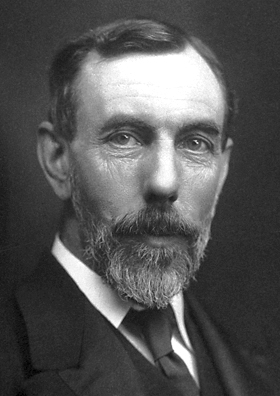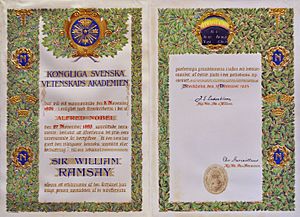William Ramsay facts for kids
Quick facts for kids
William Ramsay
|
|
|---|---|

Ramsay in 1904
|
|
| Born | 2 October 1852 Glasgow, Scotland
|
| Died | 23 July 1916 (aged 63) High Wycombe, England
|
| Nationality | British |
| Alma mater | University of Glasgow (1866–69) Anderson's University,now University of Strathclyde Glasgow (1869) University of Tübingen (PhD 1873) |
| Known for | Discovering noble gases |
| Awards | Leconte Prize (1895) Barnard Medal for Meritorious Service to Science (1895) Davy Medal (1895) Longstaff Prize (1897) Nobel Prize in Chemistry (1904) Matteucci Medal (1907) Elliott Cresson Medal (1913) |
| Scientific career | |
| Fields | Chemistry |
| Institutions | University of Glasgow (1874–80) University College, Bristol (1880–87) University College London (1887–1913) |
| Doctoral advisor | Wilhelm Rudolph Fittig |
| Doctoral students | Edward Charles Cyril Baly James Johnston Dobbie Jaroslav Heyrovský |
| Influenced | Otto Hahn |
Sir William Ramsay was a Scottish chemist. He is famous for discovering a special group of elements. These elements are called the noble gases.
In 1904, he won the Nobel Prize in Chemistry. He received it for finding these "inert gaseous elements" in the air. He shared this discovery with John William Strutt, 3rd Baron Rayleigh. Lord Rayleigh also won a Nobel Prize that year for their work on argon. After finding argon, Ramsay looked for other gases in the air. His discoveries of argon, helium, neon, krypton, and xenon changed the periodic table. They added a whole new section to it.
Early Life and Education
William Ramsay was born in Glasgow, Scotland, on October 2, 1852. His father, William C. Ramsay, was a civil engineer. His mother was Catherine Robertson. The family lived in Glasgow city center. Later, they moved to the Hillhead area. William was also the nephew of a famous geologist, Sir Andrew Ramsay.
He first went to school at Glasgow Academy. Then, he started training with a shipbuilder. But he soon decided to study Chemistry instead. He joined the University of Glasgow in 1866. He finished his studies there in 1869.
After Glasgow, he trained with chemist Thomas Anderson. He then went to Germany to study at the University of Tübingen. There, he earned his PhD in 1873. His special project was about certain acids.
Ramsay returned to Glasgow to work as an assistant. In 1879, he became a Chemistry Professor. This was at the University College of Bristol. He married Margaret Buchanan in 1881. That same year, he became the head of the college. He still managed to do a lot of research. He studied both organic chemistry and gases.
Discoveries and Career Highlights
In 1887, William Ramsay moved to University College London (UCL). He became the head of Chemistry there. This is where he made his most important discoveries. From 1885 to 1890, he wrote many papers. These papers were about nitrogen compounds. This work helped him prepare for his later gas discoveries.
A big moment happened on April 19, 1894. Ramsay was at a lecture by Lord Rayleigh. Lord Rayleigh had noticed something strange. Nitrogen made in a lab was different from nitrogen taken from the air. The air's nitrogen was slightly heavier. After talking, Ramsay and Rayleigh decided to investigate this.
In August, Ramsay told Lord Rayleigh his exciting news. He had found a new, heavy gas in the air. This gas did not react with other chemicals. He called this gas "argon". This name comes from a Greek word meaning "lazy."
In the years that followed, Ramsay worked with Morris Travers. Together, they found more new gases. These were neon, krypton, and xenon. He also found helium on Earth. Before this, helium had only been seen in the Sun's light. In 1910, he also found and studied radon.
Ramsay worked with Emily Aston from 1893 to 1902. She was a British chemist. They did experiments on minerals. They also worked on finding the weight of atoms.
In 1902, Ramsay was given a special honor. He was made a Knight Commander of the Order of the Bath (KCB). King Edward VII gave him this award.
In 1904, he received the Nobel Prize in Chemistry. This was for his amazing work on noble gases. Ramsay was a respected scientist. He became an advisor to the Indian Institute of Science. He even suggested where it should be built.
Ramsay was also the president of the British Science Association. This was from 1911 to 1912.
Personal Life
In 1881, William Ramsay married Margaret Johnstone Marshall. They had two children. Their daughter was Catherine Elizabeth, also called Elska. Their son was William George. Sadly, William George died at age 40.
Ramsay lived in Hazlemere, England, until he passed away. He died on July 23, 1916. He was 63 years old. He had nasal cancer. He was buried in the Hazlemere parish church.
Legacy
Sir William Ramsay's work is remembered in many ways.
- A blue plaque marks his former home in Notting Hill, London. It honors his life and discoveries.
- The Sir William Ramsay School in Hazlemere is named after him.
- There is a special memorial to him. It is in Westminster Abbey in London.
- In 1923, University College London opened a new department. It was for Chemical Engineering. They named it after Ramsay. This was funded by the Ramsay Memorial Fund.
- On October 2, 2019, Google celebrated his 167th birthday. They made a special Google Doodle for him.
See also
 In Spanish: William Ramsay para niños
In Spanish: William Ramsay para niños



